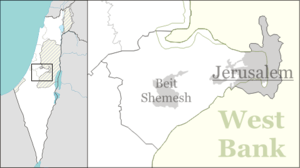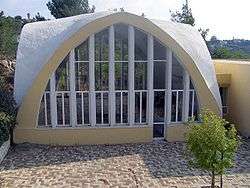Nataf
| Nataf | |
|---|---|
|
Village synagogue | |
 Nataf | |
| Coordinates: 31°49′56.28″N 35°4′4.44″E / 31.8323000°N 35.0679000°ECoordinates: 31°49′56.28″N 35°4′4.44″E / 31.8323000°N 35.0679000°E | |
| District | Jerusalem |
| Council | Mateh Yehuda |
| Founded | 1982 |
| Population (2015)[1] | 378 |
| Website | natafnik.com |
Nataf (Hebrew: נָטָף, lit. Stacte) is a communal settlement in central Israel. Located in the Judean Mountains, twelve miles west of Jerusalem, it falls under the jurisdiction of Mateh Yehuda Regional Council. In 2015 it had a population of 378.
Etymology
Its biblical name is derived from "one of the spices used in the Temple" (Exodus 30:34).[2][3]
History
Nataf was founded in 1982 on land belonging to the depopulated Arab village of Bayt Thul,[4] less than 1 km south of the village site of Nitaf.[5] It overlooks Nataf Valley, a popular hiking destination. Nataf spring is watered all year round and has a number of small freshwater pools. The name Nataf is of biblical origins and referred to the incense Stacte. Only 20% of the residents are Modern Orthodox; 80% of the residents are secular. The village has a unique unaffiliated synagogue with three sections for prayer: a men's section, a women's section and a mixed section.
Geography
Nataf is situated on a ridge bounded by Kefira Valley to the north and Hamisha Valley to the south; the elevation is around 500m above MSL. It lies at the end of a 3-mile road that passes through Abu Ghosh.
Notable residents
References
| Wikimedia Commons has media related to Nataf. |
- ↑ "List of localities, in Alphabetical order" (PDF). Israel Central Bureau of Statistics. Retrieved 16 October 2016.
- ↑ Carta's Official Guide to Israel and Complete Gazetteer to all Sites in the Holy Land. (3rd edition 1993) Jerusalem, Carta, p.358, ISBN 965-220-186-3
- ↑ Bitan, Hanna: 1948-1998: Fifty Years of 'Hityashvut': Atlas of Names of Settlements in Israel, Jerusalem 1999, Carta, p.47, ISBN 965-220-423-4 (Hebrew)
- ↑ Khalidi, Walid (1992). All That Remains: The Palestinian Villages Occupied and Depopulated by Israel in 1948. Washington D.C.: Institute for Palestine Studies. p. 290. ISBN 0-88728-224-5.
- ↑ Khalidi, 1992, p. 307
